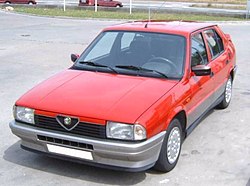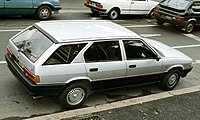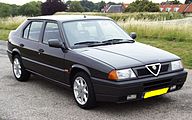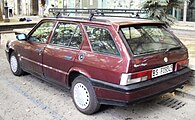Alfa Romeo 33
| Alfa Romeo | |
|---|---|
|
Alfa Romeo 33 (1983-1990)
|
|
| 33 | |
| Production period: | 1983-1994 |
| Class : | Compact class |
| Body versions : | Station wagon , station wagon |
| Engines: |
Otto engines : 1.3–1.7 liters (58–97 kW) Diesel engines : 1.8 liters (54–62 kW) |
| Length: | 4015-4200 mm |
| Width: | 1610-1613 mm |
| Height: | 1305-1359 mm |
| Wheelbase : | 2450-2475 mm |
| Empty weight : | 915-1065 kg |
| Previous model | Alfa Romeo Alfasud |
| successor | Alfa Romeo 145 / 146 |
The Alfa Romeo 33 is a compact class vehicle by Alfa Romeo that was built from mid-1983 to autumn 1994.
Model history
General
The name 33 was derived from the successful racing cars Alfa Romeo Tipo 33/2 and Alfa Romeo 33TT (Telaio Tubolare).
In June 1983, the successor to the published Alfasud as a five-door sedan with hatchback . A renewal of the model range began with the Alfa 33 (type 905). From January 1984 the Alfa 33 was also offered as a station wagon under the name Giardinetta .
The well-known boxer engines from the Alfasud continued to be used. Initially powered by the 1.2-liter and 68 PS (only available in Italy) and the 1.3-liter (79 PS), the 1.5-liter engines followed, some with double carburetors (33 Quadrifoglio Verde) with 85 to 105 hp. From autumn 1986 a 1.8-liter in-line diesel engine with three cylinders and 73 hp built by VM Motori was added (only available on the domestic market), which was based on the 2.4-liter four-cylinder with individual cylinder heads of the Alfa 90 , as well the 1.7 l boxer engine with 118 hp. The different equipment variants could be recognized by the design of the clover leaf (green, gold) as part of the type designation on the rear.
Basically, the Alfa 33 took over the chassis of the Alfasud, which has always been praised. On the front axle, however, the brakes moved from the gearbox output to the wheel hubs, which changed the steering geometry, which is why the steering responded much less spontaneously than on its predecessor. On the rear axle, the previous disc brakes gave way to drums that were sufficient for the vehicle's weight. By changing the geometry of the rear axle control arm, the Watt linkage developed significantly less resistance to side tilt, which meant that the driving behavior lost some of its previous sportiness.
The body was designed by Ermanno Cressoni , head of Alfa Romeo Centro Stile . Cressoni realized the high rear end he preferred and a double bent belt line, which was a long-cherished wish for him. Great care was taken to ensure that the body could be manufactured automatically. This eliminated the main problem of the Alfasud, namely the often poor production quality due to the negligent work ethic in the factory.
In the interior, the 33 had an elaborate innovation with an instrument panel mounted on the steering column, which was unique in this price range and at that time was otherwise only found in the Porsche 928. This ensured a clear view of the instruments regardless of the setting of the steering column.
Overall, the 33 of the Alfa Romeo line at the time was much more geared towards comfort than the Alfasud. The sometimes very long gear ratios reduced the interior noise level, but in conjunction with the relatively low-torque motors, they made for significantly slower drives than the predecessor. The comfort-oriented chassis did the rest to reinforce this impression.
In April 1988 the station wagon was renamed Sportwagon .
Facelift
In the spring of 1990 a visually and technically modified Alfa 33 appeared.
When designing the second generation (Type 907A), many design elements from other Alfa models from that time were adopted. The type 907 differed from the type 905 mainly by the now predominantly red taillights and a revised interior, which particularly concerned the dashboard. The style of the narrow tail light strip was adapted to the Alfa 164 , the grille and the headlights based on the Alfa 75 .
The facelift was followed by the 1.7 l 16V with 137 hp ( Kat version: 132 hp) and 161 Nm torque at 4600 rpm, which could be recognized by the red ring inside the chrome-plated grille. This model reached a top speed of 205 km / h and took 8.2 seconds to accelerate from 0 to 100 km / h. In the other engine versions, too, the carburettors were replaced by various injection systems ( L-Jetronic and manifold pressure-controlled injection with fully electronic ignition, etc.), the 1.3-liter engine thus developing 88 hp and the output of the 1.7-liter engine eight valves fell to 105 hp (and 148 Nm torque at 4500 rpm), among other things because of the emission control system.
A total of 866,958 sedans and 122,366 station wagons were built of the Alfa 33. Together with its predecessor, Alfasud, it is still the model with the largest number of units from the Alfa Romeo brand.
Successor of the Alfa Romeo 33 were the Alfa Romeo 145 with hatchback and equipped with rear stub 146 .
Web links
Individual evidence
- ↑ Alfa Romeo type manual, all models from 1910 to today. ISBN 3-89880-114-4 .
| Timeline of Alfa Romeo models from 1945 to today | ||||||||||||||||||||||||||||||||||||||||||||||||||||||||||||||||||||||||||||
|---|---|---|---|---|---|---|---|---|---|---|---|---|---|---|---|---|---|---|---|---|---|---|---|---|---|---|---|---|---|---|---|---|---|---|---|---|---|---|---|---|---|---|---|---|---|---|---|---|---|---|---|---|---|---|---|---|---|---|---|---|---|---|---|---|---|---|---|---|---|---|---|---|---|---|---|---|
| Type | Independent until 1933, then state-owned | from 1986 part of Fiat | ||||||||||||||||||||||||||||||||||||||||||||||||||||||||||||||||||||||||||
| 1940s | 1950s | 1960s | 1970s | 1980s | 1990s | 2000s | 2010s | 2020s | ||||||||||||||||||||||||||||||||||||||||||||||||||||||||||||||||||||
| 5 | 6th | 7th | 8th | 9 | 0 | 1 | 2 | 3 | 4th | 5 | 6th | 7th | 8th | 9 | 0 | 1 | 2 | 3 | 4th | 5 | 6th | 7th | 8th | 9 | 0 | 1 | 2 | 3 | 4th | 5 | 6th | 7th | 8th | 9 | 0 | 1 | 2 | 3 | 4th | 5 | 6th | 7th | 8th | 9 | 0 | 1 | 2 | 3 | 4th | 5 | 6th | 7th | 8th | 9 | 0 | 1 | 2 | 3 | 4th | 5 | 6th | 7th | 8th | 9 | 0 | 1 | 2 | 3 | 4th | 5 | 6th | 7th | 8th | 9 | 0 | |
| Small car | MiTo (955) | |||||||||||||||||||||||||||||||||||||||||||||||||||||||||||||||||||||||||||
| Compact class | Arna | |||||||||||||||||||||||||||||||||||||||||||||||||||||||||||||||||||||||||||
| Alfasud | 33 | 145 , 146 (930) | 147 (937) | Giulietta (940) | ||||||||||||||||||||||||||||||||||||||||||||||||||||||||||||||||||||||||
| Middle class | Giulietta Berlina | Giulia | Giulietta (type 116) | 75 | 155 | 156 (932) | 159 (939) | Giulia (952) | ||||||||||||||||||||||||||||||||||||||||||||||||||||||||||||||||||||
| upper middle class | Alfetta | 90 | 164 | 166 (936) | ||||||||||||||||||||||||||||||||||||||||||||||||||||||||||||||||||||||||
| ... | 6C 2500 | 1900 Berlina | 2000 Berlina | 2600 Berlina | 1750/2000 Berlina | Alfa 6 | ||||||||||||||||||||||||||||||||||||||||||||||||||||||||||||||||||||||
| Coupe | Giulietta Sprint | Giulia Sprint GT | Alfasud Sprint | GT (937) | ||||||||||||||||||||||||||||||||||||||||||||||||||||||||||||||||||||||||
| 1900C sprint / super sprint | 2000 sprint | 2600 sprint | 1750/2000 GT Veloce | Alfetta GT / GTV | GTV (916) | Brera (939) | ||||||||||||||||||||||||||||||||||||||||||||||||||||||||||||||||||||||
| Cabriolet | Giulietta Spider | Giulia Spider | Spider ("Duetto") | Spider (916) | Spider (939) | |||||||||||||||||||||||||||||||||||||||||||||||||||||||||||||||||||||||
| 2000 spider | 2600 spider | |||||||||||||||||||||||||||||||||||||||||||||||||||||||||||||||||||||||||||
| Sports car | Disco Volante | Tipo 33 | Montreal | SZ / RZ | 8C Competizione | 4C | ||||||||||||||||||||||||||||||||||||||||||||||||||||||||||||||||||||||
| Off-road vehicle and SUV | Matta | Stelvio (949) | ||||||||||||||||||||||||||||||||||||||||||||||||||||||||||||||||||||||||||
| Vans | Romeo | F12 / A12 | AR6 | |||||||||||||||||||||||||||||||||||||||||||||||||||||||||||||||||||||||||
| AR8 | ||||||||||||||||||||||||||||||||||||||||||||||||||||||||||||||||||||||||||||
|
|
||||||||||||||||||||||||||||||||||||||||||||||||||||||||||||||||||||||||||||





